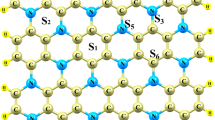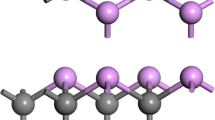Abstract
The suitability of P-doped g-C3N4 for sodium storage was assessed using density functional theory. The electronic structure of P-doped g-C3N4 was calculated and the results indicate that the presence of the P atom causes the band gap of g-C3N4 to narrow. Na adsorption on a P-g-C3N4 sheet was investigated. Projected density of states (PDOS) analysis revealed that pyridinic nitrogen atoms in g-C3N4 play the main role in Na adsorption. High binding energies were calculated for Na storage on g-C3N4, leading to a high voltage range (1–3 V) and a high Na diffusion barrier (2.3 eV). Doping the substrate with more P atoms resulted in lower voltages (below 2.2 V), easier Na diffusion (with a barrier of 1.2 eV), and therefore a material that was better suited than g-C3N4 for use in anodes.








Similar content being viewed by others
References
Delmas C (2018) Sodium and sodium-ion batteries: 50 years of research. Adv Energy Mater 1703137:1–9
Islam MS, Fisher CAJ (2014) Lithium and sodium battery cathode materials: computational insights into voltage, diffusion and nanostructural properties. Chem Soc Rev 43:185–204
Shen YF, Yuan DD, Ai XP, Yang HX, Zhou M (2014) Poly(diphenylaminesulfonic acid sodium) as a cation-exchanging organic cathode for sodium batteries. Electrochem Commun 49:5–8
Wang C, Xu Y, Fang Y, Zhou M, Liang L, Singh S, Zhao H, Schober A, Lei Y (2015) Extended π-conjugated system for fast-charge and -discharge sodium-ion batteries. J Am Chem Soc 137:3124–3130
Zhang W, Sun P, Sun S (2017) A theoretical method to predict novel organic electrode materials for Na-ion batteries. Comput Mater Sci 134:42–47
Malyi OI, Sopiha K, Kulish VV, Tan TL, Manzhos S, Persson C (2015) A computational study of Na behavior on graphene. Appl Surf Sci 333:235–243
Zhao L, Zhao J, Li YHH, Zhou Z, Armand M, Chen L (2012) Disodium terephthalate (Na2C8H4O4) as high performance anode material for low-cost room-temperature sodium-ion battery. Adv Energy Mater 2:962–965
Wang X, Li G, Hassan FM, Li J, Fan X, Batmaz R, Xiao X, Chen Z (2015) Sulfur covalently bonded graphene with large capacity and high rate for high-performance sodium-ion batteries anodes. Nano Energy 15:746–754
Sk MA, Manzhos S (2016) Exploring the sodium storage mechanism in disodium terephthalate as anode for organic battery using density-functional theory calculations. J Power Sources 324:572–581
Padhy H, Chen Y, Lüder J, Gajella SR, Manzhos S, Balaya P (2017) Charge and discharge processes and sodium storage in disodium pyridine-2,5-dicarboxylate anode—insights from experiments and theory. Adv Energy Mater 1701572:1–12
Xie X, Wang S, Kretschmer K, Wang G (2017) Two-dimensional layered compound based anode materials for lithium-ion batteries and sodium-ion batteries. J Colloid Interface Sci 499:17–32
Molaei M, Mousavi-khoshdel SM, Targholi E (2017) First-principles investigation of the complex of 2,5-furandicarbonitrile-Al-doped graphene as a possible electrode material for Na-ion batteries. Curr Appl Phys 17:272–278
Kaur G, Gupta S, Dharamvir K (2015) Structures and energetics of lithium adatom and its dimer on graphene—a DFT study. Appl Surf Sci 334:19–23
Chen Y, Manzhos S (2015) Lithium and sodium storage on tetracyanoethylene (TCNE) and TCNE-(doped)-graphene complexes: a computational study. Mater Chem Phys 156:180–187
Wan W, Wang H (2015) First-principles investigation of adsorption and diffusion of ions on pristine, defective and B-doped graphene. Materials 8:6163–6178
Du Z, Ai W, Xie L, Huang W (2014) Organic radical functionalized graphene as a superior anode material for lithium-ion batteries. J Mater Chem A 2:9164–9168
Ma CC, Shao XH, Cao DP (2012) Nitrogen-doped graphene nanosheets as anode materials for lithium ion batteries: a first-principles study. J Mater Chem 22:8911–8915
Yao LH, Cao MS, Yang HJ, Liu XJ, Fang XY, Yuan J (2014) Adsorption of Na on intrinsic, B-doped, N-doped and vacancy graphenes: a first-principles study. Comput Mater Sci 85:179–185
Molaei MM, Mousavi-Khoshdel SM (2017) Tetracyanobenzene-Al-graphene efficiency as an organic electrode material for Na-ion batteries: a theoretical approach. Comput Mater Sci 139:347–353
Hankel M, Ye D, Wang L, Searles DJ (2015) Lithium and sodium storage on graphitic carbon nitride. J Phys Chem C 119:21921–21927
Vu A, Qian Y, Stein A (2012) Porous electrode materials for lithium-ion batteries—how to prepare them and what makes them special. Adv Energy Mater 2:1056–1085
Wang Y, Tian Y, Yan L, Su Z (2018) DFT study on sulfur-doped g-C3N4 nanosheets as a photocatalyst for CO2 reduction reaction. J Phys Chem C 122(14):7712–7719
Guo Q, Zhang Y, Qiu J, Dong G (2016) Engineering the electronic structure and optical properties of g-C3N4 by non-metal ion doping. J Mater Chem C 4:6839–6847
Liu J (2016) Effect of phosphorus doping on electronic structure and photocatalytic performance of g-C3N4: insights from hybrid density functional calculation. J Alloys Compd 672:271–276
Giannozzi P, Baroni S, Bonini N, Calandra M, Car R, Cavazzoni C, Ceresoli D, Chiarotti GL, Cococcioni M, Dabo I (2009) QUANTUM ESPRESSO: a modular and open-source software project for quantum simulations of materials. J Phys Condens Matter 21:395502
Song ZZ, Zhou H (2013) Towards sustainable and versatile energy storage devices: an overview of organic electrode materials. Energy Environ Sci 6:2280–2301
Wang J, Hao D, Ye J, Umezawa N (2017) Determination of crystal structure of graphitic carbon nitride: ab initio evolutionary search and experimental validation. Chem Mater 29(7):2694–2707
Stolbov S, Zuluaga S (2013) Sulfur doping effects on the electronic and geometric structures of graphitic carbon nitride photocatalyst: insights from first principles. J Phys Condens Matter 25(8):085507
Author information
Authors and Affiliations
Corresponding author
Additional information
Publisher’s note
Springer Nature remains neutral with regard to jurisdictional claims in published maps and institutional affiliations.
Rights and permissions
About this article
Cite this article
Molaei, M., Mousavi-Khoshdel, S.M. & Ghiasi, M. Exploring the effect of phosphorus doping on the utility of g-C3N4 as an electrode material in Na-ion batteries using DFT method. J Mol Model 25, 256 (2019). https://doi.org/10.1007/s00894-019-4109-1
Received:
Accepted:
Published:
DOI: https://doi.org/10.1007/s00894-019-4109-1




